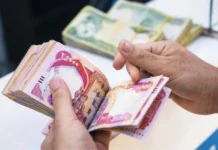Beijing — China’s economy slowed more than expected in the third quarter of 2025, growing below five percent for the first time in a year. The weaker data highlights how global trade pressure and sluggish consumer spending continue to weigh on the world’s second-largest economy.
According to the National Bureau of Statistics (NBS), China’s gross domestic product expanded 4.8 percent year-on-year from July to September — a step down from 5.2 percent in the previous quarter. It also marked the slowest pace since the same period last year, when GDP rose 4.6 percent.
The announcement comes at a sensitive moment. The Chinese Communist Party has just begun a four-day meeting in Beijing focused on long-term economic planning, while tensions with the United States are once again flaring up.
Later this month, top Chinese and U.S. officials are expected to hold in-person trade discussions, and there’s growing speculation about a possible meeting between Presidents Xi Jinping and Donald Trump.
Tariff Threats and Trade Pressure
Earlier this month, Donald Trump threatened to impose 100 percent tariffs on all Chinese goods starting November 1, in response to Beijing’s export restrictions on rare earth materials — key resources used in defense and technology industries.
Those threats have unsettled markets and raised fears of a renewed trade war just as China struggles to stabilize growth.
Analysts say the country is under increasing pressure to shift from an export-heavy model toward one driven more by domestic spending and services.
Investment and Real Estate Struggles
The latest data shows that fixed asset investment — which includes infrastructure and real estate — fell 0.5 percent year-on-year in the first nine months of 2025.
That may not sound huge, but experts call it “rare and alarming.”
Zhiwei Zhang, president and chief economist at Pinpoint Asset Management, said in a note that this drop “reflects serious weakness in the property sector” and added that stimulus measures announced recently “should help ease the pressure in the fourth quarter.”
Still, Zhang warned that the risks to fourth-quarter growth remain tilted to the downside.
Consumers Still Hesitant to Spend
Household spending remains one of the biggest challenges for China’s recovery.
Even years after the COVID-19 pandemic, many families have been cautious about spending — worried about job security, falling property values, and slow wage growth.
In September, retail sales rose just three percent from a year earlier — the weakest pace since November 2024 and down from August’s figure.
Julian Evans-Pritchard from Capital Economics said the decline reflects “the fading impact of earlier stimulus programs like the consumer goods trade-in scheme,” which had briefly boosted spending on household items earlier this year.
He added, “China’s growth is becoming more dependent on exports again — a pattern that isn’t sustainable in the long term.”
Manufacturing Shows a Silver Lining
Despite the weakness in consumption, China’s industrial production surprised on the upside, rising 6.5 percent in September, beating forecasts of five percent.
That improvement suggests that factories and export orders are holding up better than expected, even as global demand remains uneven.
The NBS said in a statement that “the national economy withstood pressure and continued to maintain steady progress,” noting that employment and prices remained relatively stable overall.
Hopes for a Reset with Washington
Over the weekend, Beijing and Washington agreed to hold a new round of trade talks, raising hopes of easing tensions before Trump’s new tariffs take effect.
The White House has softened its tone slightly, with Trump telling Fox News that 100 percent tariffs on all Chinese goods were “not sustainable” — a comment that some analysts took as a signal that Washington may be open to negotiation.
Markets will be watching closely to see whether those discussions can lead to a de-escalation or at least delay the tariff deadline.
The Party Meeting and the Next Five-Year Plan
Meanwhile, in Beijing, the Communist Party’s Central Committee is holding its fourth plenary session — a four-day gathering that’s part of its 2022–2027 term.
This meeting is expected to shape the 15th Five-Year Plan, covering the period from 2026 to 2030.
State media reports say the plan will focus on technological self-sufficiency, national security, and strengthening China’s global competitiveness — all key priorities for President Xi Jinping.
The five-year plan is central to Xi’s broader vision of a strong, self-reliant China that can withstand external shocks, whether from U.S. tariffs, geopolitical rivalries, or global supply chain disruptions.
Outlook: Slower, But Still Steady
While 4.8 percent growth may seem healthy compared to many advanced economies, it’s well below China’s pre-pandemic norm, when the country regularly posted growth above six percent.
The combination of trade friction, a property downturn, and weak domestic confidence is forcing policymakers to rethink their strategy.
Economists expect Beijing to announce new fiscal support and targeted lending programs before the end of the year to keep investment from falling further.
Still, with global demand uncertain and U.S. tariffs looming, many analysts believe China’s path to recovery will be gradual — and heavily dependent on whether domestic consumers regain confidence to spend again.







